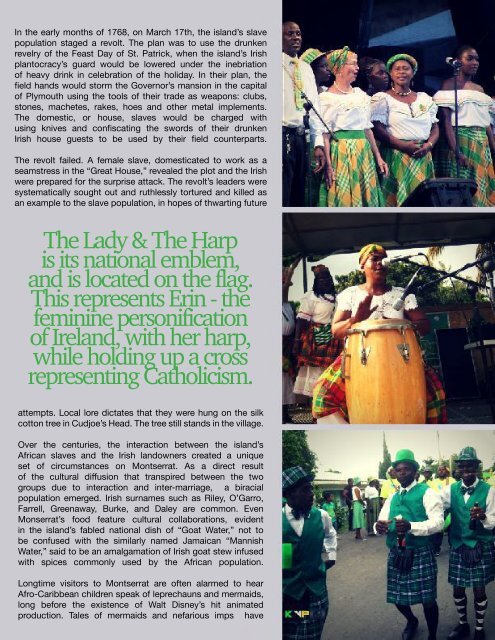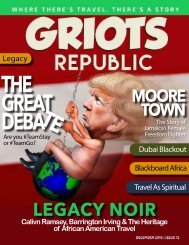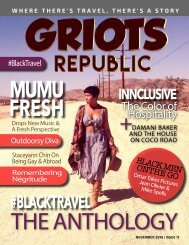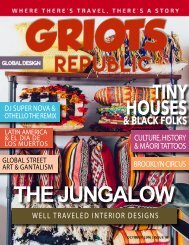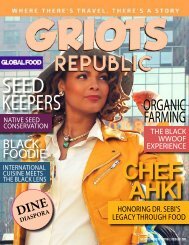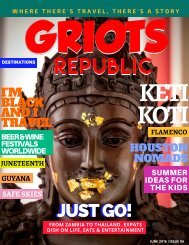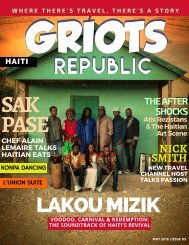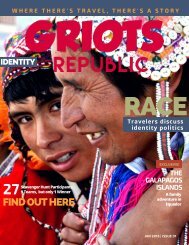GRIOTS REPUBLIC - An Urban Black Travel Mag - March 2016
ISSUE #3: IRELAND Profiles: Arlette Bomahou, Illa J, African Gospel Choir Dublin, Godfrey Chimbganda, Fabu D
ISSUE #3: IRELAND
Profiles: Arlette Bomahou, Illa J, African Gospel Choir Dublin, Godfrey Chimbganda, Fabu D
You also want an ePaper? Increase the reach of your titles
YUMPU automatically turns print PDFs into web optimized ePapers that Google loves.
In the early months of 1768, on <strong>March</strong> 17th, the island’s slave<br />
population staged a revolt. The plan was to use the drunken<br />
revelry of the Feast Day of St. Patrick, when the island’s Irish<br />
plantocracy’s guard would be lowered under the inebriation<br />
of heavy drink in celebration of the holiday. In their plan, the<br />
field hands would storm the Governor’s mansion in the capital<br />
of Plymouth using the tools of their trade as weapons: clubs,<br />
stones, machetes, rakes, hoes and other metal implements.<br />
The domestic, or house, slaves would be charged with<br />
using knives and confiscating the swords of their drunken<br />
Irish house guests to be used by their field counterparts.<br />
The revolt failed. A female slave, domesticated to work as a<br />
seamstress in the “Great House,” revealed the plot and the Irish<br />
were prepared for the surprise attack. The revolt’s leaders were<br />
systematically sought out and ruthlessly tortured and killed as<br />
an example to the slave population, in hopes of thwarting future<br />
The Lady & The Harp<br />
is its national emblem,<br />
and is located on the flag.<br />
This represents Erin - the<br />
feminine personification<br />
of Ireland, with her harp,<br />
while holding up a cross<br />
representing Catholicism.<br />
attempts. Local lore dictates that they were hung on the silk<br />
cotton tree in Cudjoe’s Head. The tree still stands in the village.<br />
Over the centuries, the interaction between the island’s<br />
African slaves and the Irish landowners created a unique<br />
set of circumstances on Montserrat. As a direct result<br />
of the cultural diffusion that transpired between the two<br />
groups due to interaction and inter-marriage, a biracial<br />
population emerged. Irish surnames such as Riley, O’Garro,<br />
Farrell, Greenaway, Burke, and Daley are common. Even<br />
Monserrat’s food feature cultural collaborations, evident<br />
in the island’s fabled national dish of “Goat Water,” not to<br />
be confused with the similarly named Jamaican “Mannish<br />
Water,” said to be an amalgamation of Irish goat stew infused<br />
with spices commonly used by the African population.<br />
Longtime visitors to Montserrat are often alarmed to hear<br />
Afro-Caribbean children speak of leprechauns and mermaids,<br />
long before the existence of Walt Disney’s hit animated<br />
production. Tales of mermaids and nefarious imps have


